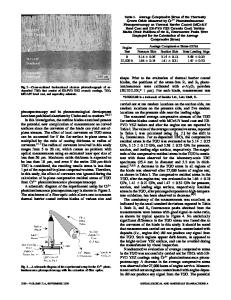Nondestructive Measurement of In-Plane Residual Stress in Silicon Strips
- PDF / 794,077 Bytes
- 5 Pages / 411.12 x 635.4 pts Page_size
- 18 Downloads / 376 Views
and analytical techniques, such as X-ray diffraction, micro-indentation, birefringence, and etc [I][61,have been developed to measure stresses in silicon due to thermal profiles in growth furnaces, changes in microstructure and interdiffusion of atomic species, and the deposition of thin films. This paper describes an experimental technique and analysis to evaluate the in-plane longitudinal residual stresses in thin, flat rectangular strips of silicon. Shadow moirdt 781s with the Carre phase stepping scheme is used to obtain the deflection of the specimen subjected to three-pointbending. A model based on the theory of thin plates with large deflection is developed to reconstruct the in-plane longitudinal stresses from the measured deflection at different bending loads. A linear regression scheme of the stresses versus bending loads is employed to resolve the in-plane longitudinal residual stress. Residual stress in a sample silicon specimen is presented. Tensile longitudinal in-plane residual stresses are found in the central area and compressive longitudinal residual stresses are found near the edges. THEORY There is interaction between the in-plane stresses and the bending of a plate. The tensile stresses make a plate appear more rigid and more difficult to be bent and the compressive stresses make the plate appear more compliant and easier to be bent. With the theory of thin plates with large deflection, in the area where there is no surface pressure and the in-plane 283 Mit. Res. Soc. Syrup. Proc. Vol. 5910 2000 Materials Research Society
normal stresses in the x direction are dominant such that all other stress components are negligible, the in-plane stress a., can be expressed as the following[91: Eh2 V 2V 2w o,=12(1 _/12) a2w(1 ax2 where w is the deflection; E, g and h are the Young's modulus, Poisson's ratio and thickness of the plate, respectively. This equation can be solved for thin rectangular plates subjected to three point bending as shown in figure 1 if it is assumed that: 1. The in-plane residual stresses are uniform through the thickness; 2. The out-of-plane residual stresses are negligible; 3.
The in-plane normal stress in the longitudinal direction is dominant and independent of the
precise longitudinal position; 4. The in-plane normal residual stresses are symmetric about the x-axis.
z [iii]
YA B Si
rXiXr 0
L (a)
(b) Figure 1 Rectangular silicon strip
When residual stresses are present in a web specimen, the in-plane stress a, is the combination of the in-plane elastic stresses a' caused by the bending load and the in-plane residual stresses o"• a• =aR +'e
(2)
If it is assumed that the variables of the deflection, x and y, are separable, the specimen is loaded symmetrically about the x-axis and the misalignment between the specimen and the grating is taken into account, the deflection can be expressed by the following polynomial series:
w(x,y)= F(x kY+,cy 2' f
(3)
i=0
where k and ci's are constants and depend on the bending load and residual stresses. When keeping the first three
Data Loading...








